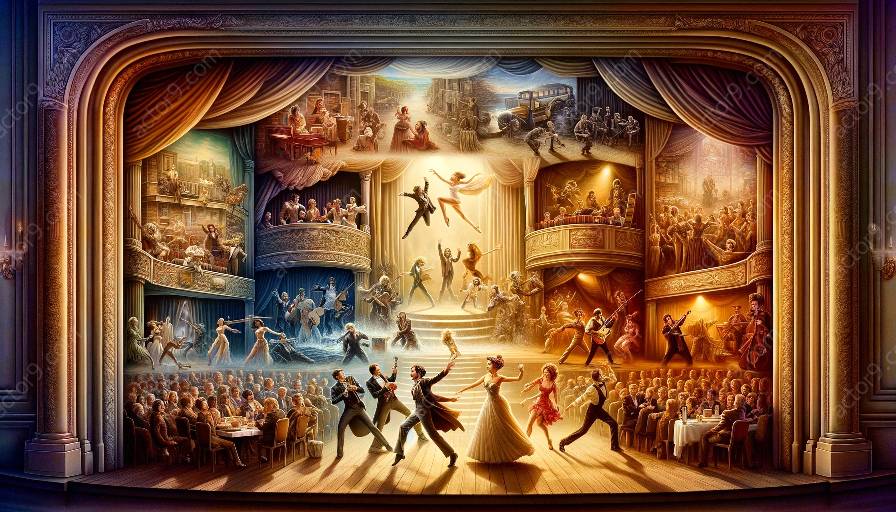Musical theatre is a vibrant and dynamic art form that involves the integration of various elements to create a fully immersive experience for the audience. One such crucial element is the use of sound effects, which play a significant role in enhancing the overall atmosphere and storytelling in musical theatre productions. From classic Broadway musicals to contemporary avant-garde performances, sound effects are utilized to evoke emotions, create ambience, and drive the narrative forward in diverse ways.
The Role of Sound Effects in Musical Theatre
Sound effects serve as an integral part of the auditory landscape in musical theatre, amplifying the impact of the performance and adding depth to the storytelling. They can range from subtle ambient sounds to dramatic crescendos, and their usage is carefully orchestrated to align with the musical compositions and choreography. By effectively integrating sound effects, theatre productions can transport the audience to different settings, evoke specific moods, and accentuate pivotal moments in the narrative.
Enhancing Musical Theatre Styles and Genres
The use of sound effects is intricately linked to the diverse styles and genres within musical theatre. For instance, in traditional Broadway musicals such as 'The Phantom of the Opera', sound effects are employed to create an aura of mystery and suspense, heightening the dramatic tension in scenes. The haunting sounds of creaking doors, ghostly whispers, and echoing footsteps contribute to the eerie ambiance, capturing the essence of the Gothic romance genre.
Conversely, in contemporary and experimental musical theatre, sound effects are utilized to push artistic boundaries and challenge conventional storytelling techniques. Avant-garde productions often incorporate innovative soundscapes and unconventional noises to subvert audience expectations and immerse them in abstract, non-linear narratives. By leveraging unconventional sound effects, these performances reinvent the auditory experience, aligning with the avant-garde style's emphasis on non-traditional forms of expression.
Creating Emotional Impact
Sound effects play a pivotal role in eliciting emotional responses from the audience, enriching the theatrical experience across various musical theatre styles. In musicals with intense and climactic sequences, such as 'Les Misérables' or 'Miss Saigon', the strategic use of powerful sound effects heightens the audience's emotional investment, intensifying the impact of pivotal moments. Explosions, thunderous crashes, and reverberating echoes intensify the grandeur and gravity of the scenes, forging a powerful connection between the audience and the performers.
Technical Marvels in Musical Theatre
Advancements in sound technology have revolutionized the use of sound effects in musical theatre, allowing for immersive and technically sophisticated productions. From surround sound systems to spatial audio design, modern musical theatre benefits from a diverse range of techniques that can seamlessly integrate sound effects with live performances. This technical prowess enables the creation of multi-dimensional auditory experiences that elevate the overall production value and captivate audiences in a myriad of ways.
The Integration of Sound Effects with Music and Choreography
Sound effects are seamlessly woven into the fabric of musical theatre, aligning with the musical compositions and choreography to form a cohesive and captivating performance. Whether it's the synchronized timing of footsteps with dance movements or the harmonious blending of orchestral arrangements with ambient soundscapes, the integration of sound effects enhances the immersive nature of musical theatre. By synchronizing sound effects with music and choreography, productions achieve a synergy that resonates with the audience on both sensory and emotional levels.
Future Innovations and Possibilities
As musical theatre continues to evolve, the use of sound effects holds immense potential for further innovation. Emerging technologies such as 3D audio and interactive soundscapes present exciting avenues for creating unparalleled immersive experiences that defy traditional boundaries. The future of sound effects in musical theatre is poised to embrace cutting-edge advancements, enabling directors, composers, and sound designers to push the boundaries of creativity and amplify the impact of live performances in unprecedented ways.
Conclusion
The use of sound effects in musical theatre is a multifaceted and indispensable component that enriches the art form across an array of styles and genres. From accentuating emotional cues to creating atmospheric backdrops, sound effects navigate the intricate landscapes of musical theatre, shaping memorable experiences for audiences worldwide. As technology, creativity, and storytelling converge, the integration of sound effects in musical theatre continues to captivate and inspire, marking a harmonious symphony between sound, spectacle, and storytelling.




































